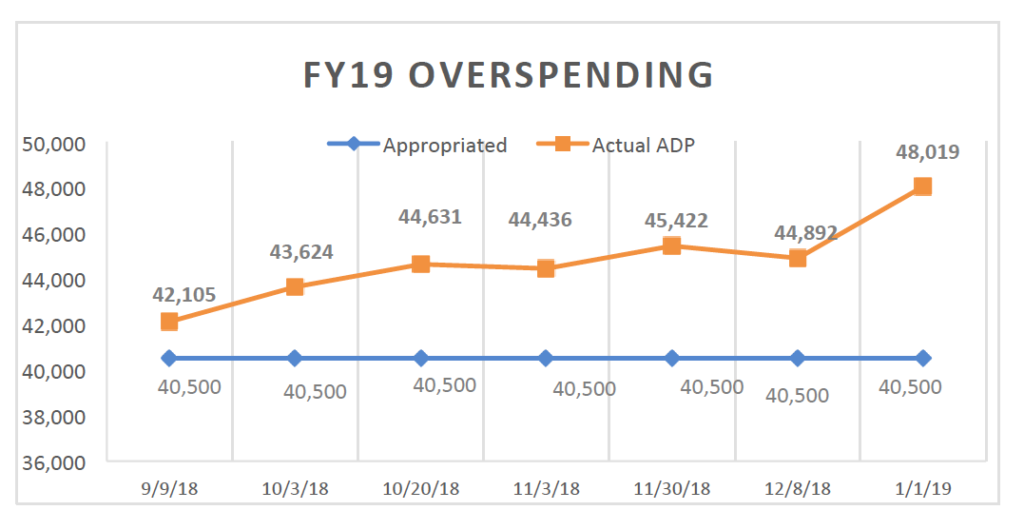In fiscal year (FY) 2006, the number of Congressionally authorized immigration detention beds was only 21,500 and has steadily increased: 27,500 in FY 07, 33,400 in FY 10, 34,000 for FY 12 through FY 16, and 40,500 in FY 18:
Since FY 18, the Congress has not appropriated additional money for detention beds. Despite the Congressional authorization of only 40,500 detention beds, ICE has consistently spent more money detaining more people. As of January 1, 2019, ICE peaked at 48,019 detained individuals, all without a new bill passed in the Congress and recently released data shows that ICE continues to increase detention with 49,057 immigrants in detention on February 6.
Source: Detention Watch Network
If ICE is ONLY funded by Congress for 40,500 beds, how is it maintaining 48,019 beds?
Instead of working with Congress through the regular Congressional appropriations process to increase funding before spending, ICE spends first, then runs to Congress to cover irresponsible over-spending. The tool – reprogramming funds mid-year to cover the shortfall, including money reserved by Congress for FEMA, nuclear detection, biological and chemical attack preparedness, and other critical priorities. Then, at the start of the next fiscal year’s appropriations process, ICE uses that inflated, over-spending level as its floor, again asking Congress for more money.
Is ICE’s over-spending justified by a public safety or national security emergency that could not be foreseen or dealt with through the normal appropriations process?
No. The overspending is not due to smart planning, effective and careful arrest and detention with clear priorities. Instead, the Trump administration has massively increased arrests and detentions with no rational priority system and certainly not a system that justifies irregular spending. ICE data shows that an average of 51% of the daily detained population in October 2018 was “non-criminal” and 51% posed “no threat.” Hardly an emergency justifying over-spending Congressionally-appropriated amounts.
Comparing ICE arrest data from October 2016 through June 2017 and the same period one year later (October 2017 through June 2018) the Associated Press (AP) found that “ICE arrests of noncriminals increased 66 percent” and arrests of criminals barely increased by nearly “2 percent.” Comparing ICE deportation data from fiscal years 2016 and 2017, AP found “there was a 174 percent increase [in 2017]…of those with no criminal convictions. Deportations of those with convictions rose nearly 13 percent over the same period.”
According to an AP review of ICE data obtained by the Transactional Access Clearinghouse at Syracuse University (TRAC), of “more than 220,000 deportees in the 2017 fiscal year, 79,270 had no convictions….” and “1 in 4” of those deported with criminal records were convicted of illegal entry or re-entry, “the first- and third-most common charges among deportees.” “Traffic offense” was the fifth most common crime committed by those deported with criminal records.
Furthermore, under the Trump administration, immigration attorneys have reported a “massive departure” from the previous administration in releasing immigrants and asylum-seekers on bond. According to PBS, attorneys say bonds are being set so high that most immigrants and asylum-seekers, including parents, are unable to post bond, and therefore, languish in detention for longer than necessary.
Finally, under the Trump administration, ICE changed a “risk assessment tool” developed in 2013 from recommending release in certain situations to always recommending detention.


